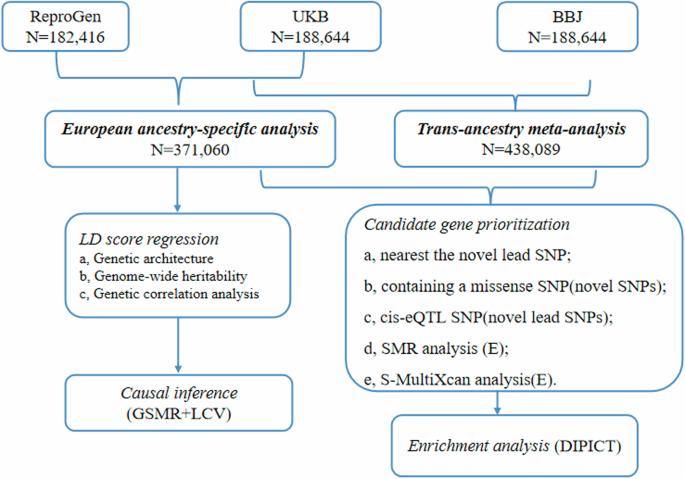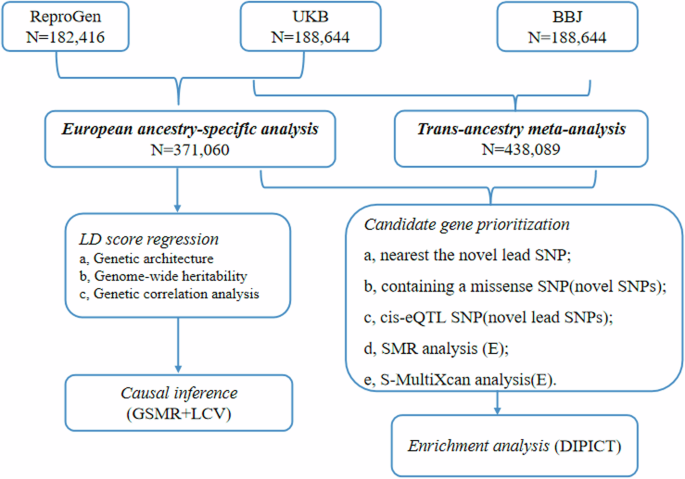月经初潮年龄的遗传结构及其对其他特征的因果效应。
IF 2.6
3区 生物学
Q2 GENETICS & HEREDITY
引用次数: 0
摘要
初潮年龄(AAM)是女性青春期的标志。它是一种与各种成人疾病相关的遗传性状。然而,人们对决定月经初潮年龄并将其与疾病风险联系起来的遗传机制知之甚少。为了揭示 AAM 的遗传基础,我们对来自欧洲和东亚血统的 3 项全基因组关联研究的多达 438,089 名女性进行了联合关联研究。随后,我们进行了一系列生物信息学分析和因果推断,以探索相关基因位点的深度注释,并推断 AAM 与其他复杂性状/疾病之间的因果关系。这项规模最大的荟萃分析在全基因组显著性水平(P -8)上共发现了21个新的AAM相关位点,其中4个是欧洲血统特异性位点。功能注释优先考虑了新发现位点上的 33 个候选基因。AAM与67个复杂性状之间存在显著的遗传相关性。进一步的因果推断表明,AAM对13个性状有影响,包括强迫生命容量(FVC)、高血压、首次活产年龄等,表明较早的AAM会导致较低的FVC、较差的肺功能、高血压和较早的首次(最后)活产年龄。富集分析确定了 5 个富集组织,包括下丘脑中部、下丘脑下叶系统、神经分泌系统、下丘脑和视网膜。我们的研究结果可能会为阐明AAM的决定机制以及AAM与女性某些特征之间的遗传相互作用提供有用的见解。本文章由计算机程序翻译,如有差异,请以英文原文为准。


The genetic architecture of age at menarche and its causal effects on other traits
Age at menarche (AAM) is a sign of puberty of females. It is a heritable trait associated with various adult diseases. However, the genetic mechanism that determines AAM and links it to disease risk is poorly understood. Aiming to uncover the genetic basis for AAM, we conducted a joint association study in up to 438,089 women from 3 genome-wide association studies of European and East Asian ancestries. A series of bioinformatical analyses and causal inference were then followed to explore in-depth annotations at the associated loci and infer the causal relationship between AAM and other complex traits/diseases. This largest meta-analysis identified a total of 21 novel AAM associated loci at the genome wide significance level (P < 5.0 × 10−8), 4 of which were European ancestry-specific loci. Functional annotations prioritized 33 candidate genes at newly identified loci. Significant genetic correlations were observed between AAM and 67 complex traits. Further causal inference demonstrated the effects of AAM on 13 traits, including forced vital capacity (FVC), high blood pressure, age at first live birth, etc, indicating that earlier AAM causes lower FVC, worse lung function, hypertension and earlier age at first (last) live birth. Enrichment analysis identified 5 enriched tissues, including the hypothalamus middle, hypothalamo hypophyseal system, neurosecretory systems, hypothalamus and retina. Our findings may provide useful insights that elucidate the mechanisms determining AAM and the genetic interplay between AAM and some traits of women.
求助全文
通过发布文献求助,成功后即可免费获取论文全文。
去求助
来源期刊

Journal of Human Genetics
生物-遗传学
CiteScore
7.20
自引率
0.00%
发文量
101
审稿时长
4-8 weeks
期刊介绍:
The Journal of Human Genetics is an international journal publishing articles on human genetics, including medical genetics and human genome analysis. It covers all aspects of human genetics, including molecular genetics, clinical genetics, behavioral genetics, immunogenetics, pharmacogenomics, population genetics, functional genomics, epigenetics, genetic counseling and gene therapy.
Articles on the following areas are especially welcome: genetic factors of monogenic and complex disorders, genome-wide association studies, genetic epidemiology, cancer genetics, personal genomics, genotype-phenotype relationships and genome diversity.
 求助内容:
求助内容: 应助结果提醒方式:
应助结果提醒方式:


